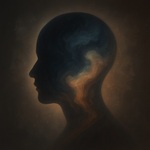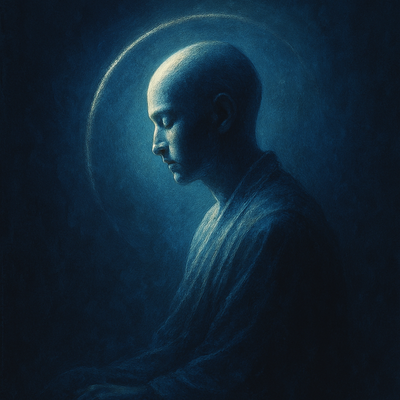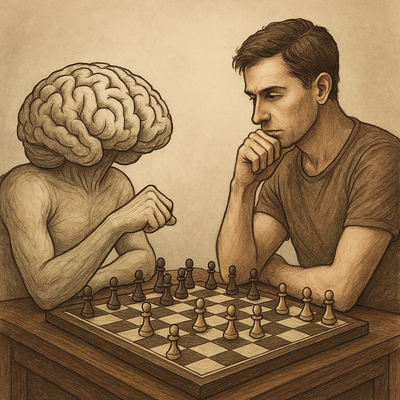When we think of "me", we usually think of the calm, peaceful "me" when we feel good.
But sometimes we experience a moment of anger, jealousy, sadness or embarrassment; we react instantly with that emotion.
When the heat of the event wears off, we regret it, we cannot justify that behavior to ourselves, we say, "I wish I had not acted that way.
It is as if it is not "me" who reacts that way, but a separate me who performs a predetermined automatic behavior.
Sometimes even our inner voice comes in and scolds us:
"Does it look good on you?"
"There you go, you've done it again..."
"Know yourself; that's exactly the kind of person you are..."
And it nags us.
The strange thing is that we are the ones doing the behavior. We are the ones who don't approve of it. This voice inside us is also coming from us.
Then it seems like the time has come to ask:
Is it all 'me', or is there another me inside me?
In this article, we will try to understand how the experience we call "I" is formed and the relationship between body, mind and consciousness.
The Philosophical and Scientific Background of the Subject
The Philosophical and Scientific Background of theperspective">Philosophical Perspective
Mevlânâ and "Layers of the Self"
Mevlânâ, He sees the being we call "I" not as a single fixed identity, but as a journey that unfolds layer by layer.
He says that human beings should mature their inner world along the line of nafs - heart - soul.
We can think of these three layers as follows:
1. Nafs (Reactive Self)
This level is the first area where life touches us.
It is where emotions rise and fall fast, defenses are triggered, automatic reactions are given.
Here the self is focused on self-preservation.
You are angry. You are offended. You are defensive.
Everything is sudden, everything is hot.
2. Heart (Feeling and Meaning Seeking Self)
The waves of the Self settle down a bit and one begins to choose one's inner voice, emotion and intention.
Here the self begins to ask "What do I feel?" "What do I want?".
Response subsides, awareness arises.
3. Spirit (Silent Witness, Deep Self)
This is the space where words diminish, interpretations dissolve, and only thought can be observed.
The self here ceases to be a story, becomes a silent awareness.
Like a center.
Not rushing.
Not proving.
Just seeing. (1*)
Mevlânâ is not telling us anything like "The nafs is bad, the soul is good."
He is just describing a path.
Because sometimes one becomes anger, sometimes surrender, sometimes a deep calm.
It's all human.
But what we call "me" is shaped by which one we hold on to the most.
The soul speaks. The heart hears. The soul witnesses.
And most of the time we don't realize which of these three layers is speaking.
Thus the question arises, "Did I do it, or is it something else inside me?"
Maybe the answer is waiting silently between these layers. Maybe the "me" is much deeper than we think.
Merleau-Ponty: The self emerges in the body's relation to the world
According to the phenomenologist Merleau-Ponty, what we call the "self" is not an abstract entity sitting inside the mind.
The self is born where the body comes into contact with the world.
In other words, we experience the world not only by thinking, but by touching, hearing, seeing, smelling, moving.
And the sum of these experiences determines how we feel ourselves.
According to him, what is called the self is actually:
The weight of the hand as it opens the door,
The warmth of the eye as it recognizes a face,
The defensive position you take without realizing it when your shoulders suddenly tense,
And the inner silence that tries to interpret whether it is "danger or excitement" when your heart suddenly speeds up...
There is the "I".
Not as an abstract thought, but in the living relation of the body to the world. (2*)
Merleau-Ponty tells us in summary:
"Thought cannot exist without the body. For I know the world through my body."
This means:
We not only experience the world; the world shapes us.
A look, a word spoken in a tone, a skin, a distance, a warmth, a coldness...
All leave a mark on our body.
And we take those imprints, give them meaning and say:
"This is who I am."
But the "I" is the imprint of the sensations we experience in our body,before the thoughts we have.
This perspective changes where we should look for the self.
The self may not be hidden in thought, but in the silent memory of the body.
Even where words stop, the body continues to speak.
Nietzsche writes "There is no thinking self; there is thought, which we then call 'I'." (3*)
We have all heard of Descartes' "I think, therefore I am". Nietzsche thinks a little differently about this. He was referring to this when he said, "When they say 'I think' they are in fact presupposing too much.
The self is invented after the thought."
In short, according to him, we often think that when a thought appears, we are its owner. It's as if there is a fixed "me" sitting in the corner of our mind and it generates all the thoughts.
But most thoughts come spontaneously.
An emotion rises.
A word appears.
A reaction arises.
And we catch up with their emergence afterwards.
What actually happens is this:
A thought arises in the head.
And we call it "I".
If thought is a wave, the self is not like the sea from which that wave emerges, but like the shape that wave leaves on the surface.
This is where Nietzsche points:
The self is not a single entity from within; it is a flow, a becoming, a state of relation.
We are not fixed.
We reconstitute ourselves every moment.
Emotion changes, thought changes, the body changes, the world changes, and the self emerges as a floating trace in these changes.
That's why sometimes we ask "why did I do that?"
Because the doer, the interpreter, the regretterare not the same fixed person.
The self is not a point, but a movement, a being.
And perhaps the point is not to define ourselves, but to recognize ourselves as we are becoming, and to constantly direct and develop ourselves in a way that is good for us.
Scientific Perspective
Somatic Marker Theory (Damasio)
The body stores emotion; the mind only names it.
According to neuroscientist Antonio Damasio, when we experience an event, it is the body that reacts first, not the mind. The body speaks first.
The heart speeds up.
The breath constricts.
The shoulders contract.
A knot appears in the stomach.
There is a feeling of heaviness in the chest, or on the contrary, a feeling of openness...
These sensations are the physical traces left by the experience.
And we often try to explain the cause of these traces later with our mind.
That is, first the emotion is experienced in the body, then the mind labels it.
Damasio calls this the somatic marker. The body carries the emotional baggage of past experiences and in a new situation recalls the same emotion.
For example, when someone raises their tone of voice, the memory of a scolding, perhaps as a child, is revealed in the body, and we become defensive.
The decision is not made thinking at that moment. The mind comes into play only later and says:
"I am angry."
"I am sad."
"I am hurt."
Emotion happens in the body; thought only writes its story. (4*)
This view breaks the notion that the "I" is enclosed in the mind.
Because if the body hides the past and our reactions are learned and not spontaneous, then what we call "I" is not just thinking, feeling, acting, but a living process in which all these are intertwined.
The self is not a fixed identity, but a pattern of body-mind-emotion interactions that is reconstituted every moment.
Enactive Cognition (Varela & Thompson)
The self emerges from the organism's continuous interaction with the world.
Enactive cognition
was first introduced in the academic work The Embodied Mind, published in 1991 by neuroscientist Varela, his student and collaborator Thompson, and cognitive philosopher Rosch.
This approach is based on 3 basic scientific observations.
1- The Nervous System Organizes Itself in Interaction with the World
The nervous system does not work like a computer receiving data from outside. Information from the senses is not passively received.
The nervous system actively makes sense.
This is called Active Inference / Predictive Processing in neuroscience.
In a nutshell, what is being said is:
The brain constantly predicts, updates its prediction when it encounters the world.
This process constantly changes the sense of self.
2 - No Mind Without Body
This is not just a philosophical claim, it is a neurophysiological finding. In other words, we can define the things in our brains that lead to a sense of self as follows:
Signals from internal organs (interoception)
Muscle tone, posture, sense of movement (proprioception)
These two directly determine our emotional states and sense of self.
For example, even a slight change in heart rhythm changes one's perception of "I am confident/not confident". (Confirmed in studies by Barrett, Critchley, Damasio.)
In other words, what we call the self is a combination of body, perception and emotion. It is not "thought" alone.
3- If Interaction with the Environment is Interrupted, the Self Disintegrates
Isolation tanks, sensory minimization in space missions, and social isolation experiments have shown us empirically that as interaction is interrupted, the sense of self begins to dissolve and is headed towards destruction.
In other words, what we call the self exists as long as our contact with the world continues.
When contact decreases, our perception of time disintegrates, our sense of self becomes blurred, even our inner speech starts to become silent, and if contact is cut off, it can become completely silent.
Here we understand that the self is formed within the world. And it is reshaped with every contact. (5*)
The coldness of a stone, the warmth of a look, the vibration that a melody creates within us...
All of them reconstruct who we are in that moment
The organism (i.e. us) is in a constant state of interaction. We hear, we move, we react, we make sense of it.
And this cycle never ends.
"I" is a form of relationship that is constantly born within this cycle, between the body and the environment.
It is not an outcome, but a process of becoming.
In this approach, the self is not a product of the mind separate from the world; on the contrary, it is the relationship with the world.
In other words, I emerge as long as I am in contact with the world. When contact is broken, the self changes form.
In other words, the "self" is not a static identity, but a story of encounters that is rewritten with each new experience.
In everyday life, we feel it like this:
When we feel expanded in a nature walk, contracted in an argument, dissolved in music...
In fact, our self changes shape according to its interaction with the environment.
The self is not a closed center,it is an open system.
The Etractive approach tells us: If you want to understand the self, look for it in your relations with the outside world, not inside.
Because the "I" does not exist alone. It is always touched by something, someone, a moment.
Social and Cultural Context
When we say "I", we often mean the voice speaking from within, but we don't often think about where that voice comes from.
As if it has been inside us since the moment we were born, as if it has always belonged to us...
But the self begins to take shape in the mirror of others from the moment we open our eyes to the world.
Mead: The "I" takes shape in the mirror of others.
Social psychologist Mead argues that the self is not innate; it is learned through the reactions, gaze and attitudes of others. We learn about ourselves from the reactions, looks and tones of others.
A child first notices this: When I smile, my mother smiles too. That means I'm doing something good. When I raise my voice, the atmosphere gets tense. That means there is danger.
In other words, the answer to the question "who am I?" is filtered through relationships
From this perspective, we can say that the self is the sum of reflections. (6*)
Goffman - Identity is a stage performance.
Goffman, a sociologist, says that people play different roles according to different situations in daily life and that identity is actually made up of these social stage performances:
We are all on a stage in daily life.
We behave differently at home, differently at work, differently with friends, differently in a crowd.
This is not hypocrisy.
It is the social adaptation mechanism of human beings.
There is no single self within us; different surfaces of self emerge in different environments.
Identity is like a role played according to the moment in time.
And this role can, over time, turn into a mask that we think is the real me. (7*)
Family, culture and definitions of success shape the inner voice
"Be strong."
"Be quiet."
"Please everyone."
"If you succeed, you will be valued."
"Don't make mistakes."
"Don't show weakness."
"Don't cry."
Which of these sentences have we not been taught?"
The tone of our inner voice is often not our own voice. It comes from family, from culture, from school, from praise, from hurt, from shame, from pride.
And after a while, we begin to think that voice is our own.
Even the tone of our inner voice may not be our own.
Sometimes we think it is "me" speaking inside us. But maybe that voice is an echo that we have been carrying inside us for years.
Real Problems and Solutions
Problem
After a certain point, one starts repeating the same phrases about oneself.
"I am like this."
"That's just the way I am."
"That's the way I react."
"I can't change."
"I'm not a man."
But most of the time we don't choose these sentences. They are actually taught, reflected, rewarded or punished. The sad thing is that most of us thought that story was our voice.
Well, we only thought it was...
We kept silent to look good,
We bent down to avoid losing,
We hid our feelings to stay strong,
We kept correcting ourselves to be loved...
And over the years, the voice inside us turned into an automatized narrator:
"You did the same thing again."
"Does that suit you?"
"Will you never change?"
Over time, our reactions become reflexes without thinking, our emotions spontaneously explode or are suppressed, our identity becomes frozen, rigid, fixed.
It is as if there is only one "me" inside us and it always has to stay that way.
This is where the pain is born:
We stop living who we are.
We stop living us.
And when this happens, one becomes alienated from oneself.
From the outside it looks "normal". But a silent sentence echoes inside us:
"It is as if I am not myself."
Solution Suggestions
Mindfulness of the body: Feeling the "I" in the body, not just in the mind
The moment I realized that the self is not just thoughts, was the moment I started to return to my body.
When I notice a feeling rising, I now first ask:
"Where does this touch in my body?"
Sometimes the chest tightens.
Sometimes the abdomen narrows.
Sometimes the shoulders lift up without me noticing.
And just being there for a few breaths reminds me that:
Thought comes after the body speaks.
So what I call "me" is not just the voice in my head; I am the story my body is silently telling.
Maybe this is what is hard to hear:
The body does not lie in truth.
Watching the inner voice: hearing, not interpreting
It is not necessary to fight the voice that speaks inside us. Nor is it necessary to try to correct it.
The more I tried to suppress my inner voice, the bigger it became. It became harsher. The louder it spoke.
One day I tried just listening.
No interpretation.
No justification.
No forcing it to shut up.
I just said"Okay, I hear you.I hear you." And I listened, as if it were an outside voice.
And then what happened?
The voice softened.
Sometimes it even went completely silent.
Because sometimes the voice inside us is not shouting, it wants to be heard.
Leaving the story: experiencing life instead of defining yourself
For a long time I tried to describe myself in sentences:
"I am this person."
"I behave like this."
But I realized that each of these sentences was freezing me.
I was not trying to understand who I am, but to fix who I am.
But human beings are not fixed. Every day changes a little. Every contact leaves a new mark.
That's why I tell myself this now:
"I don't have to explain myself; I can live myself."
It's not necessary to name a behavior to understand it.
It's not necessary to label an emotion to embrace it.
It's enough to realize:
Is this emotion good for me, or does it constrict me?
If it can be changed, it is transformed.
If it cannot be changed, it is accepted as it is.
Sometimes just staying there is enough to rebuild the self.
Conclusion and Message to the Reader
Perhaps what we call "me" is not that fixed identity that we try to describe and explain ourselves.
Perhaps the "I" is the flow itself, reborn with every contact, emerging in a sudden tightening of the body, a softening of the breath, a rising emotion from within, and the awareness that silently follows it all.
If no moment is the same as the last, we cannot remain the same.
I is not a completed answer; it is a question that is asked anew every moment.
And now the question turns to you:
Is the voice that speaks inside you really yours, or is it just an echo that you were taught years ago?
You don't have to answer this question "correctly". In fact, the answer may not come right away. Maybe it's even better if it doesn't.
Because sometimes the transformation begins not when we find the answer, but only when we dare to hear it.
In the next post, we will look at this silent space itself:"The Silent Witness"
I wonder if it is possible to have an awareness that does not silence thoughts, that does not suppress them, that simply watches them?
Perhaps that is where what we call "me" emerges...
Till then, stay with love, awareness and yourself.
Source
- Mevlânâ Celâleddîn-i Rûmî - Masnavi
- Merleau-Ponty - Phenomenology of Perception
- Nietzsche - On the Genealogy of Morality / Beyond Good and Evil
- Antonio Damasio - Descartes' Error
- Varela, Thompson & Rosch - The Embodied Mind
- George Herbert Mead - Mind, Self, and Society
- Erving Goffman - The Presentation of Self in Everyday Life







